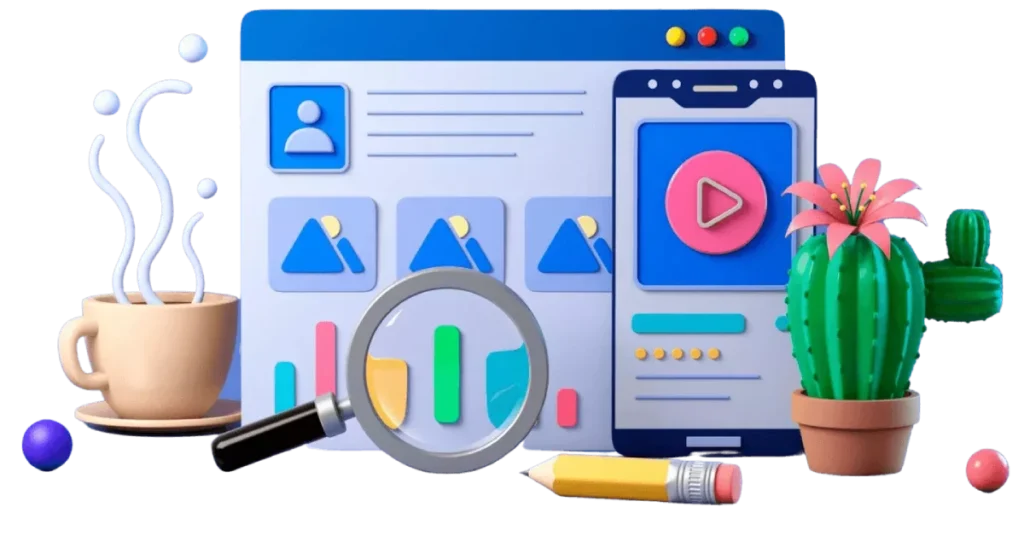SEO for small business is not just a buzzword. It is a powerful tool. It helps your local venture shine online. Think of it as your digital storefront. It attracts customers actively looking for what you offer. In today’s busy online world, being visible is everything. People search for everything online. They look for local services, products, and information. If your business does not appear, you miss out.
I am here to guide you. We will explore how SEO works for small businesses. I will show you how to get more customers. This guide covers essential strategies. It also reveals advanced tactics. You will learn practical tips and tools. We will also discuss common missteps to avoid. My goal is to help you build a strong online presence.
Understanding Search Intent: The Core of Effective Small Business SEO

Search intent is simple. It is the “why” behind a search. Why did someone type those words into Google? Google wants to give users the best answer. If your content matches their need, Google shows your page.
There are four main types of search intent:
- Informational: People want to learn. They ask “how to” or “what is.”
- Example: “How to choose a local plumber.” Your blog post about plumbing tips fits this.
- Navigational: People look for a specific website. They know where they want to go.
- Example: “Your Business Name hours.” Your “About Us” or contact page is perfect.
- Commercial Investigation: People research before buying. They compare options.
- Example: “Best accounting software for small businesses.” Your comparison article or service benefits page helps them decide.
- Transactional: People are ready to buy. They want to complete an action.
- Example: “Buy custom cakes online.” Your product page or booking form is exactly what they need.
To succeed with SEO for small business, you must know your customers’ intent. Google’s search results page (SERP) offers clues. Look at the “People Also Ask” sections. See if local maps appear. Check for shopping results. Keyword research tools also reveal intent. Aligning your content with intent brings the right visitors.
Foundational SEO Strategies for Small Businesses

Every successful online presence starts with a strong foundation. Let’s build yours.
Keyword Research: Speaking Your Customers’ Language
Keywords are the words people type into search engines. Finding the right ones is crucial.
- Brainstorming: Start with your products or services. What do you offer? What problems do you solve?
- Example: If you own a bakery, think “cupcakes,” “wedding cakes,” “gluten-free bread.”
- Free Tools: Google offers excellent free tools.
- Google Keyword Planner: Helps you find new keywords. It shows search volume.
- Google Search Console: Shows what people search to find your site.
- Google Autocomplete: As you type in Google, it suggests phrases. These are popular searches.
- People Also Ask (PAA): This Google feature lists common questions. They are related to your search.
- Long-Tail Keywords: These are longer, more specific phrases. They have lower search volume. They also have less competition. They often show stronger intent.
- Example: Instead of “bakery,” try “best gluten-free chocolate chip cookies in Austin.” This targets a very specific customer.
- Relevance over Volume: For a small business, relevance matters most. A keyword with lower searches but high relevance brings better customers.
On-Page SEO: Making Your Website Shine
On-page SEO optimizes elements on your website. This helps search engines understand your content.
- Title Tags & Meta Descriptions: These are your ad copy in search results.
- Title Tag: The clickable headline in search results. Make it compelling. Include your main keyword. Keep it concise (around 50-60 characters).
- Meta Description: The summary is below the title. Write it to entice clicks. Include keywords naturally. It does not directly affect ranking. It influences click-through rates.
- Header Tags (H1, H2, H3): These structure your content.
- H1: Your main heading. Use one per page. Include your primary keyword.
- H2, H3, etc.: Subheadings break up text. They make it readable. Use related keywords in them.
- Content Quality & Depth: Your content must be helpful. It must be comprehensive. It needs to be unique. Answer user questions fully. Provide real value. Google rewards helpful content.
- Image Optimization: Images make your site engaging. Optimize them for SEO.
- Alt Text: Describe the image for visually impaired users. Include keywords.
- File Size: Compress images. Faster loading times improve user experience.
- Descriptive Filenames: Use relevant names (e.g.,
chocolate-chip-cookies-austin.jpg).
- Internal Linking: Link relevant pages on your site. This guides users. It also helps search engines discover content. It spreads “link equity” throughout your site.
- URL Structure: Keep your URLs clean and descriptive.
- Example:
yourbusiness.com/services/plumbing-repairIs better thanyourbusiness.com/page?id=123.
- Example:
Technical SEO: Building a Solid Website Foundation
Technical SEO ensures your website is crawlable and indexable. This means search engines can find and understand it.
- Mobile-Friendliness: Most searches happen on mobile phones. Your website must look good and work well on all devices. Google uses mobile-first indexing. This means it primarily uses the mobile version of your content for ranking.
- Site Speed: Fast loading times are crucial. Users leave slow websites. Google prioritizes fast sites. Use tools like Google PageSpeed Insights to check your speed. Optimize images, use browser caching, and reduce unnecessary code.
- SSL Certificate (HTTPS): This encrypts data between your site and users. It shows a padlock icon in the browser. Google considers HTTPS a ranking factor. It builds trust with visitors.
- XML Sitemaps: This file lists all important pages on your site. It helps search engines find and crawl your content efficiently. Submit your sitemap to Google Search Console.
- Robots.txt: This file tells search engine crawlers which pages to access or avoid. Use it carefully. Incorrect use can block your site from search results.
- Schema Markup (Structured Data): This special code helps search engines understand your content better. It can create “rich snippets” in search results.
- Example: Local business schema shows your address, hours, and reviews directly in search. Product schema displays pricing and ratings.
Local SEO: Connecting with Customers Nearby
Local SEO is vital for small businesses. It helps you appear in local searches.
- Google Business Profile (GBP) Optimization: This is your most important local SEO tool.
- Claim and Verify: Make sure you own and verify your GBP listing.
- Accurate NAP: Your Name, Address, and Phone number must be consistent everywhere online. This builds trust with Google.
- Optimize Details: Fill out all sections completely. Choose the correct business categories. Add services, hours, and high-quality photos.
- GBP Posts and Q&A: Use posts to announce specials or news. Answer customer questions promptly.
- Online Reviews & Reputation Management: Reviews build trust. They influence local rankings.
- Encourage Reviews: Ask happy customers to leave reviews on Google, Yelp, and industry-specific sites.
- Respond to Reviews: Thank customers for positive feedback. Address negative reviews professionally and promptly. This shows you care.
- Local Citations & Directories: A “citation” is any mention of your business online. List your business on relevant online directories. Examples include Yelp, Yellow Pages, and local chambers of commerce. Consistency in NAP data across these listings is key.
- Location-Specific Content: Create content tailored to your service areas.
- Example: If you are a plumber in Phoenix, create pages for “plumbing services Phoenix,” “emergency plumbing Scottsdale,” etc. This targets specific local searches.
To truly solidify your online presence and show search engines your business’s authority, you’ll want to build strong connections across the web. For a deeper exploration of how to earn valuable mentions and improve your local search standing, check out our detailed guide on Link Building For Local SEO: 8 Ways to Rank Higher in Google SERP.
Link Building: Earning Authority and Trust
Backlinks are links from other websites to yours. They act like votes of confidence. More high-quality backlinks signal authority to Google.
- Understanding Backlinks: Google sees backlinks as a sign of your website’s credibility.
- Quality over Quantity: One link from a reputable local news site is worth more than many low-quality links.
- Strategies for Small Businesses:
- Local Partnerships: Collaborate with other local businesses—exchange links where relevant.
- Guest Blogging: Write articles for other local or industry websites. Include a link back to your site.
- Broken Link Building: Find broken links on other websites. Suggest your content as a replacement.
- Create Shareable Content: Produce valuable content that others naturally want to link to.
- Local Associations: Join your local chamber of commerce or business associations. They often have member directories with links.
Advanced Strategies & New Horizons

Many small businesses focus on the basics. That’s a great start. But what if you want to stand out even more? Let’s explore some deeper strategies. These can give you a significant edge.
Deeper Competitive Insights
You know your main rivals. You might even check their keywords. But what if you could understand their entire online blueprint? Imagine knowing their strongest links. Picture seeing their content strategy in detail. This goes beyond simple keyword checks. It helps you find unique ways to attract customers.
- Analyzing Their Backlinks: Which websites link to your competitors? Can you earn links from those same sources? This reveals powerful outreach opportunities.
- Content Strategy Deep Dive: What articles or pages bring them the most traffic? Are there topics they miss entirely? Perhaps they cover a topic, but their content is thin. You can create something much better.
- Technical Audit of Competitors: Look at their website’s technical health. Is their site fast? Do they use schema markup? Learning from their setup can improve your own.
- Finding Your Unique Corner: This deep analysis helps you spot underserved keywords. It reveals content areas where you can become the authority. It’s like finding a hidden path to success.
- Tools for This: Advanced SEO platforms like Ahrefs, Semrush, or Moz offer robust competitive analysis features. They let you explore competitor backlinks, top pages, and keyword rankings.
Showing Your SEO’s Real Impact
Traffic numbers are nice. But what about actual sales? How many leads did your SEO efforts generate? Small businesses need clear proof of return on investment (ROI). We can track more than just website visits. We can connect SEO directly to your business goals.
- Setting Up Conversion Tracking: This means telling Google Analytics what actions matter. This could be a form submission, a phone call from your website, or an online purchase.
- Calculating Your ROI: You can create simple formulas. How much did you spend on SEO? How much revenue did it bring? This shows the financial return. For example, if SEO brought 10 new customers, and each customer spends $500, that’s $5000 in revenue. Compare that to your SEO investment.
- Attribution Models: How does SEO fit into the customer’s journey? A customer might find you through Google, then visit your social media, and then call. Attribution models help you understand SEO’s role in that full path.
- Regular, Simple Reports: Forget complex spreadsheets. Create easy-to-understand reports. Show the number of leads, sales, or calls from organic search. This helps you make smart business decisions.
Expanding Your Content Reach
Blog posts are great. But what if your customers prefer video? Or maybe they listen to podcasts? Imagine reaching them in new ways. You can build comprehensive authority around your core topics.
- Video SEO: Create helpful videos. Optimize them for YouTube and Google. Use strong titles, descriptions, and relevant keywords. Add transcripts to your website. This helps both users and search engines.
- Podcasts: Start a podcast about your industry. This builds a loyal audience. It positions you as an expert. You can repurpose blog content into audio.
- Interactive Content: Quizzes, calculators, or simple tools engage users. They provide real value. Other websites might even link to them. This boosts your authority.
- Content Pillars & Topic Clusters: Instead of many random articles, create a “pillar” page. This covers a broad topic. Then, create “cluster” content. These are detailed articles on subtopics. Link them all together. This shows Google your deep expertise.
- Strategic Content Promotion: Don’t just publish and hope.
- Email Marketing: Share new content with your email list.
- Community Forums: Share your expertise in relevant online groups (e.g., local Facebook groups, industry forums).
- Syndication: Explore opportunities to republish your content on other platforms.
SEO for Online Shops
Selling products online brings unique SEO needs. General advice helps, but e-commerce requires specialized tactics.
- Product Page Optimization: Each product page needs unique, descriptive titles and meta descriptions. Use high-quality images. Include customer reviews prominently. Make calls to action clear.
- Category Page Optimization: Optimize these pages for broader product terms. For example, a “Women’s Shoes” category page.
- Product Schema Markup: This special code tells Google about your products. It can show pricing, availability, and review ratings directly in search results. This makes your listings more appealing.
- Managing Product Variations: Ensure all product options (sizes, colors) are crawlable. Google should understand them.
- Handling Out-of-Stock or Discontinued Products: Use 301 redirects for discontinued items. This sends users and search engines to a relevant new page. For temporary out-of-stock items, mark them.
- Internal Search Optimization: If your site has a search bar, make it efficient. Users finding products quickly improves their experience. This can also provide insights into what customers seek.
Staying Ahead with Search Updates
Google constantly refines its algorithms. These changes can affect your rankings. Knowing how to adapt is key. The Google Search Central SEO Starter Guide is a foundational resource for improving website visibility. It explains how SEO helps search engines understand your content, making it easier for users to find your site. The guide covers key areas like ensuring Google’s crawlers can access your content, organizing your site logically with descriptive URLs, creating high-quality and relevant content, and optimizing elements like links and images. It’s a practical guide to making your website search engine-friendly and user-focused.
- Staying Informed: Follow reliable SEO news sources. They report on major Google updates.
- Understanding Updates: Some updates are “core updates.” They affect the overall ranking. Others target specific issues, like spam. Learn what each update focuses on.
- Identifying Potential Issues: Did your traffic drop suddenly? Check Google Search Console for messages. Look for unusual ranking changes. These could signal an issue.
- Recovery Strategies: If an update impacts you, there are steps to take. This often involves improving content quality. It might mean fixing technical issues. It means aligning more closely with Google’s guidelines.
- Proactive Measures (E-E-A-T): Build a site Google trusts. E-E-A-T stands for Experience, Expertise, Authoritativeness, and Trustworthiness.
- Experience: Show you have real-world experience with your topic.
- Expertise: Demonstrate deep knowledge.
- Authoritativeness: Be recognized as a go-to source in your field.
- Trustworthiness: Ensure your site is secure, accurate, and transparent.
Essential Tools and Resources for Small Business SEO
You don’t need a huge budget for SEO. Many tools are free or affordable.
- Free Tools:
- Google Analytics: Tracks website traffic and user behavior.
- Google Search Console: Shows how Google sees your site. It identifies issues.
- Google Business Profile: Essential for local businesses.
- Google Keyword Planner: Helps find keywords.
- Google PageSpeed Insights: Checks your website’s speed.
- Freemium/Paid Tools:
- Ahrefs, Semrush, Moz: Comprehensive SEO platforms for keyword research, competitor analysis, and link building.
- Surfer SEO: Helps with content optimization.
- BrightLocal, Whitespark: Specialized tools for local SEO and citation building.
- Screaming Frog: A website crawler for technical SEO audits.
- Learning Resources:
- Google’s SEO Starter Guide: A great official resource.
- Reputable SEO Blogs: Follow industry leaders for the latest trends and tips.
Common SEO Mistakes Small Businesses Should Avoid

Avoid these pitfalls to save time and effort.
- Ignoring Local SEO: If you serve a local area, local SEO is your best friend. Do not overlook it.
- Keyword Stuffing: Do not cram keywords into your content. This harms readability. Google can penalize it.
- Neglecting Mobile Experience: Your site must work perfectly on phones.
- Having a Slow Website: Speed matters. Optimize your site for fast loading.
- Not Creating Fresh, Valuable Content: Regular, helpful content keeps your site relevant.
- Ignoring Customer Reviews: Reviews build trust. Respond to them.
- Expecting Instant Results: SEO takes time. It is a long-term strategy. Be patient and consistent.
- Not Tracking Progress: Use analytics tools. See what works and what does not.
Google’s Mobile-First Indexing means Google primarily uses the mobile version of a website for crawling, indexing, and ranking. While a mobile version isn’t mandatory, it’s strongly recommended. Key practices include using responsive design, ensuring all content (including lazy-loaded elements) is accessible and renderable on mobile, and maintaining consistent primary content, structured data, and metadata between mobile and desktop versions. The guide also highlights common pitfalls like missing titles or blocked mobile URLs.
Conclusion: Your Path to Sustainable Online Growth
SEO for small business is a powerful investment. It helps your business connect with customers. It builds trust and drives growth. Focus on understanding what your customers search for. Create valuable content that answers their questions. Optimize your website for both users and search engines. Pay special attention to local SEO.
Remember, consistency is key. Keep learning. Keep adapting. The online world changes, but the core principles of helpfulness remain. By following these steps, you build a strong online presence. You attract more customers. You secure your business’s future. Take control of your online destiny. Start your SEO journey today.




